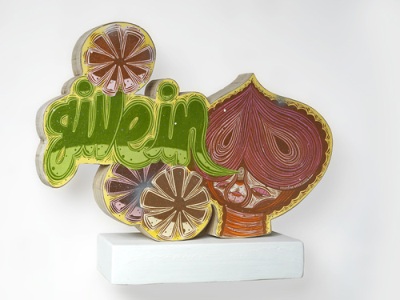
April 8, 2010
Thomas Campbell, "YAR," at Gregory Lind Gallery

Thomas Campbell, Givein, 2010. Courtesy Gregory Lind Gallery
Thomas Campbell is a versatile, imaginative self-taught artist, photographer and filmmaker. His creative roots are in the street culture of skateboarding and the sea culture of coastal California and surfing. His artworks and distinctive style derive directly from graffiti, tagging, and skateboarder and surfer slang, united by an unwavering curiosity and bravado to incorporate anything into his pieces. He is apparently adept at everything he turns his hand and mind to, including painting and drawing, sewing and stitching, printmaking and silk screening, and sculptures of wood, bronze, and found objects, particularly gourds, which he skillfully transforms into captivating objects of art. He has made three full-length surfing films: The Seedling (1999), Sprout (2004), and most recently, The Present (2009). He is also the creative director for an independent record label, Galaxia, based in Santa Cruz. He has had solo exhibitions of his art in New York, Paris, Tokyo, The Netherlands, San Francisco, Los Angeles and Morocco. With a creative juggernaut of this much force and energy, you might indeed ask, “What else can he do?” He is the definitive and quintessential example of what a creative individual can achieve working outside the mainstream of the traditional art establishment.
The current exhibition of some twenty-five of Campbell’s artworks at Gregory Lind Gallery is a delight and a treat. His wry and clever sense of humor and irony, whereby he makes an art form of whimsy, pervades all his work. Many of his pieces include images of iconic comical figures and odd-shaped characters, like the stylized cigar-shaped Indian who is his main spokesperson, and an onion head Buddha, which he has also reproduced on T-shirts. This cigar-shaped Indian, with a feather sticking out of the top of his head, looks very much like Alfred Jarry’s famous iconoclastic character, Ubu roi. These cigar Indians are particularly noteworthy and appealing in Horizontal f..k yeah (2010) and the three silkscreen prints, YAR (2010) made exclusively for this show, which they announce. The former is a laminated and painted wooden sculpture in the shape of the comical cigar Indian lying on his side. Carefully painted and artistically integrated text in the body of the figure says, “Personal Affirmation,” a phrase that occurs in other pieces, often with the number of the “Personal Affirmation” adjoined, as in the five-panel painting If you can (2009-2010), which incorporates “Personal Affirmation No 8343.” Text is also included on gourds attached to and extending beyond the square borders and frames of the works and which serve as speech bubbles for the characters in the paintings and sculptures. For instance, in YAR (a sailor’s and pirate’s nautical term, of course), one of two cigar Indians paddling in a canoe asks: “Are we gonna go to Thomas Campbell’s Exhibition at Gregory Lind Gallery,” while the other figure says, “HELL YEAH Start paddling.”
Some of the most appealing sculptures in this show are literal word sculptures, in which written verbal quips and phrases are carved out of thick laminated wood, like Well, ummm yeah (2010), or decorated with flowers that look like slices of lemons and limes and include favorite images, like the Buddha head, as in Givein (2010). These pieces have affinity with masterful famous concrete verbal artworks by such artists as the Scots poet, writer, and landscape artist, Ian Hamilton Findlay, who also employs nautical themes.
Campbell uses repeated graffiti-like strokes and overlapping, interlocking Images similar to the techniques of well-known Rock poster artists of the 1970s and 1980s. Many of his pieces employ repeated waves, one on top the other such that they also look like stylized branches of pine trees. This effect creates very “busy” and vibrant content that fills the ground and surfaces, which when coupled with his repeated use of his iconic cartoon figures, produces works that are reminiscent of William T. Wylie’s techniques and his use of favorite characters, like his famous Dunce and Mr. Unnatural. When I mentioned this similarity to Campbell, he readily admitted that he was unfamiliar with these characters and Wiley’s work, which to me enforces his counter-culture roots and the original sources of his art in creative street smart graffiti, skateboarding, and surfing art. Recognizing this, however, does not bespeak an art that is primitive, crude and amateurish. Quite the contrary, Campbell’s work is quite sophisticated and intelligent, particularly confirmed by three recent sculptures on view, two bronze works, Charles (2009) and Der (2010), and a clever painted gourd mounted on a bronze stand, titled Oceanic Vastness (2010). All three of these sculptures in fact incorporate elongated curving gourds and their stems.
In Charles the gourd is transformed into a strange bird-like creature; in Der the gourds become the horns of a mythic bull-headed creature that looks like the Minotaur, both frightening and formidable in its classic presence and superb execution. Oceanic Vastness is truly a very clever “found” piece. Campbell here transforms the simple curved gourd into a whale, whose painted designs look like scrimshaw etchings. These include three iconic cigar-shaped Indians riding the waves on the whale’s side with the graphic texts: “TRIP OUT,” “OH TOTALLY,” and “OCEANIC VASTNESS.” This clever and simple conversion of an organic plant into another “vastly” different creature of similar shape produces not only a wry smile but respectful acknowledgement of the imagination and craftsmanship of this prolific, artist.